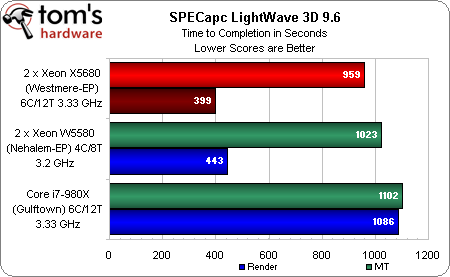Intel Xeon 5600-Series: Can Your PC Use 24 Processors?
The professional space is peppered with products derived from the desktop. Today we're looking at Intel's Xeon X5680 CPUs, which look a lot like Core i7-980X, only they're optimized for dual-socket platforms. We're also introducing new Adobe CS5 tests.
Benchmark Results: SPECviewperf 11 And SPECapc LightWave 9.6
The recently-released SPECviewperf 11 is meant primarily to measure OpenGL graphics performance. It includes new viewsets from up-to-date versions of LightWave, CATIA, EnSight, Maya, Pro/ENGINEER, SolidWorks, Siemens Teamcenter Visualization Mockup, and Siemens NX.
| SPECviewperf 11 | 2 x Xeon X5680 | 2 x Xeon W5580 | 1 x Core i7-980X |
|---|---|---|---|
| catia-03 | 21.32 | 22.3 | 22.5 |
| ensight-04 | 11.4 | 11.86 | 12.03 |
| lightwave-01 | 40.06 | 40.87 | 41.88 |
| maya-03 | 8.94 | 14.55 | 16.02 |
| proe-05 | 7.74 | 8.09 | 9.21 |
| sw-02 | 32.58 | 32.64 | 33.14 |
| tcvis-02 | 16.24 | 16.66 | 16.41 |
| snx-01 | 13.92 | 16.55 | 16.6 |
We were hoping to see performance in these tests at least impacted by the platform hosting our Nvidia Quadro FX 3800 graphics card. No such luck, it seems. In fact, the opposite seems to be true. Consistently, the highest scores come from the single-CPU Core i7-980X—though it should be noted that the differences here are fairly small.
There are actually three results garnered from the LightWave 9.6 test. However, they’re most easily generated using the Discovery mode. Once you register for a trial version of the software, you get a popup before Layout launches that ends up preventing the Interactive test from completing. The solution seems to be running this SPECapc and our custom workload using a full, registered copy. We’re working with NewTek to make that happen.
Even still, we get some interesting results from the Render and multi-task tests (yes, the LightWave benchmark was developed specifically to take advantage of threaded platforms). The render test, specifically, sees a massive speed-up moving from a single socket to a dual-socket Xeon W5580 and then to a dual Xeon X5680 configuration. Though not as pronounced, the MT test also clearly favors a pair of Xeon X5680s over the W5580s, which in turn best a single Core i7-980X.
Get Tom's Hardware's best news and in-depth reviews, straight to your inbox.
Current page: Benchmark Results: SPECviewperf 11 And SPECapc LightWave 9.6
Prev Page Benchmark Results: Sandra 2010 Next Page Benchmark Results: CS4 And Introducing Adobe’s CS5 Suite
